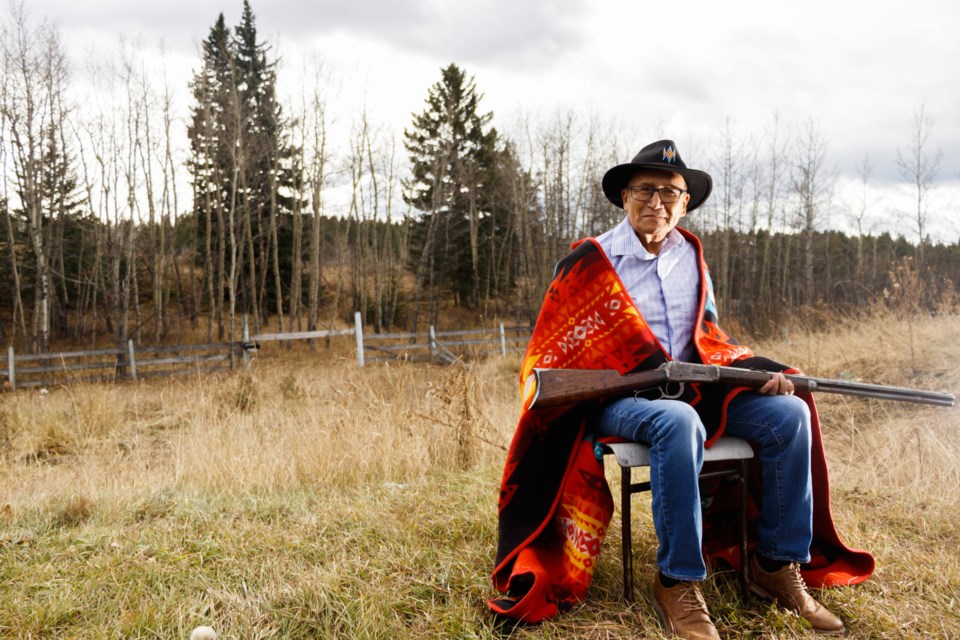STONEY NAKODA — The story Isaac of Rollinmud is legendary in the Stoney Nakoda community.
Children in the community have grown up entranced by the legend of Isaac, elder Uma Wesley said, and how he outsmarted a Banff park warden in the area that is now known as Dead Man’s Flats while out hunting for beaver.
She added they take great pride in the hamlet bearing the story of his name.
His great-grandson Roland Rollinmud will be creating a work of art this year to commemorate the incredible moment. He was inspired to capture it on canvas because in 2014 the MD of Bighorn debated changing the name of Dead Man’s Flats.
“They questioned me to see if we [Stoney Nakoda] wanted to change it,” Rollinmud said.
The hamlet’s name has two origin stories, he explained, one the story of the gruesome murder of two brothers and the true origin story of his great grandfather.
In the first story, two brothers went to war against each other and died in the 1920s.
“The two brothers came from the East looking for adventure, or some money to start their own business,” Rollinmud said. “They found coal – that was big money that they found.”
They started their own business and greed soon set in, he said, and the brothers killed each other dying side by side.
“It was so brutal that Dead Man’s Flat hamlet wanted to change the name,” Rollinmud said.
However, he said that the story is not where the hamlet gets its name.
The Stoney version has been passed down over generations and features Rollinmud’s great grandfather Isaac.
The Bow Valley is a traditional hunting ground and space to gather berries and medicine, he said.
Around 100 years ago, the Europeans were beginning to establish settlements in the area, transforming how the Nakoda had lived on the land for thousands of years.
They were no longer allowed to hunt animals and in the springtime, Wesley added, explaining they needed to hunt beavers because their meat is rich in nutrients the community needs.
They were cut off from animals by the creation of Banff National Park, Rollinmud said, making Isaac actions all the more meaningful. At the time, what is now Dead Man's Flats and Canmore were inside the boundary of the park.
“In the springtime, we need the beaver,” Wesley said.
Isaac travelled from Eden Valley to the Bow Valley because the area was rich with resources he needed, including medicines.
“Dead Man’s Flat is a very important area for the Stoneys,” Rollinmud said. “The beaver is used in everything – it’s the best food delicacy.”
Isaac found and killed a beaver using his 1894 30-30 Winchester rifle, Rollingmud said. However, the sound of the rifle echoed across the valley drawing the attention of a park warden.
Sensing that something was amiss, Isaac soon noticed park warden Jack Fuller surveilling the area.
Acting quick on his feet, Isaac covered his body in the beavers blood, hid the carcass and his belongings in an indent in the ground and played dead, Wesley said with a laugh.
Fuller did not check to see if Isaac was alive and left to report the “death” to the authorities.
As soon as Fuller left, Isaac took off travelling all night to return home to Eden Valley and safety.
“He [Isaac] got up, grabbed his beaver and took off,” Wesley said with a booming laugh. “He did that for our survival – otherwise he probably would have died in prison.”
She added that Isaac’s actions were that of a good warrior and defender of the people.
“He outsmarted the game warden,” Rollinmud said with a beaming grin. “That’s the first time the law managed to let this guy escape.”
The story demonstrates how the Stoney Nakoda people were smart and able to survive, even though the European settlers actively looked to erase them and their way of life, Wesley said
“He’s a hero. My [great] grandfather outsmarted the game warden,” Rollinmud said. “That’s the true story … I would like the name [Dead Man’s Flat] to remain.”
Rollinmud is an internationally renowned artist and has pledged to use his skills to find a way to preserve and celebrate the story of his great-grandfather to ensure it is honoured by future generations.
He is hoping to memorialize the event on a 36" by 48" painting.
The painting will include important items including references to the beaver and Isaac’s 30-30 Winchester rifle that is a cherished family heirloom.
Celebrating Isaac’s legacy is one of the many ways elders in the Stoney Nakoda are actively working to engage with and educate youth in the area, Rollinmud said. They must understand the history of the Stoney Nakoda, he said, and painting is one way to help preserve their culture and heritage.
It can be frustrating at times, he said, because people seem indifferent to who the Stoney are, how they have arrived and survived in the Bow Valley, their history and their culture.
“I’m trying to represent the Stoneys as much as I can,” Rollinmud said.






